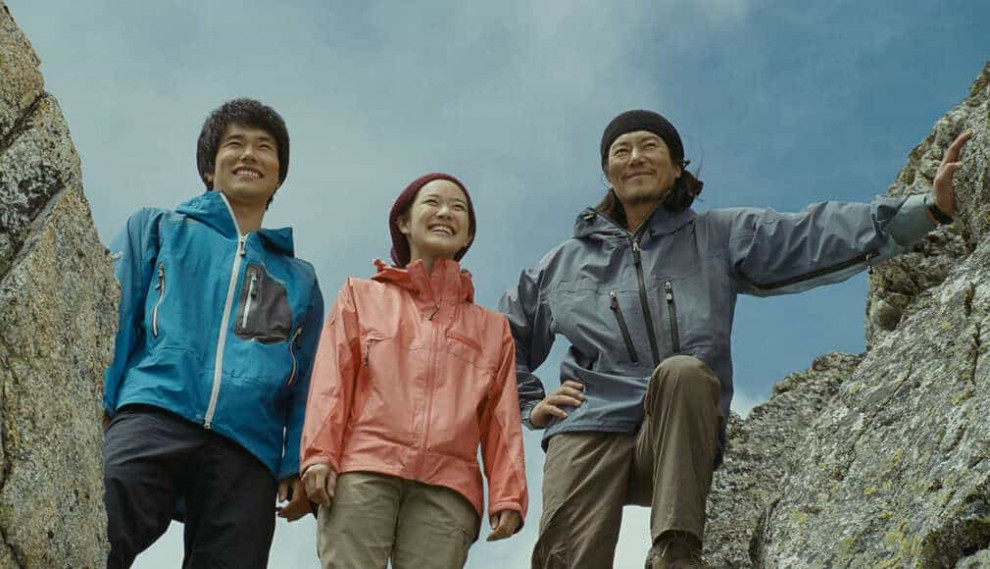Daisaku Kimura made a name for himself working as a cinematographer in Japanese cinema since the 70's, with his work netting him awards from the Japanese Academy three times, namely for “House on Fire”, “Yukai” and “Chorus of Angels“. However, the surprise came when he first transitioned to the director's chair with “Mt Tsurugidake”, a film that took the Academy by storm in 2010, winning six awards including the ones for direction and cinematography for Kimura. Having exhibited his love and his ability to shoot about and in the mountains, Kimura continued with the theme in “Climbing to Spring”, although in much more tender fashion.
“Climbing to Spring” is screening at Ulju Mountain Film Festival 2019

The story is based on Ryouhei Sasamoto's homonymous novel and revolves around Tooru, a young man who, as the story begins, works as a securities trader in Tokyo. However, his past is completely different, since he spent much of his childhood on the Tateyama Mountain Range with his father, who taught him the secrets of surviving on the mountains and how to run the family-owned cabin, located at an altitude of 3000 meters. His father was quite strict, something that eventually placed a dent in their relationship that resulted in Tooru leaving for Tokyo. However, he is not happy in his current working place and the death of his father during a rescue operation has him returning to his home region and eventually to the cottage. When his mother announces her will to sell the place, not being able to run it on her own, Tooru decides to step in and take over. Initially,he struggles, but with the help of the always cheerful Ai, who is also a great cook and Goro, an experienced climber and permanent member of the cabin crew, he adapts gradually. Extreme situations, however, seem to be the rule of the mountain.
Daisaku Kimura directs a film that focuses on two topics: following your parent's footsteps and “surviving” in the mountains, with both arcs making a comment on the values of living in the country in contrast to the city. In that fashion, the film's comments are quite obvious, as we witness Tooru learning who (how great actually) his father was through testimonies of a number of friends and cabin guests, all of which seem to hold him in very high regard, occasionally even owing their lives to him. Through these stories, Kimura highlights the importance of running establishments like the one in the movie, whose employees offer to their guests not just lodging and food, but also assistance in the face of danger. Kimura presents this theme through a number of episodes, all of which stress the aforementioned opinion, but also the fact that the people who indulge in mountain climbing can frequently be reckless and also kind of eccentric.

Furthermore, he also highlights the fact that the strictness of the previous generation (as also exhibited in a side arc involving Satoshi, a childhood friend of Tooru who struggles to follow in his father's carpenter's footsteps) was well based, particularly in the case of living and working in the mountains, where danger lurks everywhere.
The presentation of the mountain brings us to the second main topic of the movie, with Kimura showcasing both the beauties and the dangers of high-altitude climbing in the most impressive way. His own cinematography succeeds fully in that regard, depicting images of extreme beauty and extreme harshness with the same accuracy and artfulness. Furthermore, the way he shoots the cottage highlights its sanctuary nature in the most eloquent way. Keiichi Itagaki's editing allows the episodic nature of the narrative to unfold through a very fitting, relatively fast pace, through the frequent use of well placed flashbacks. Ikebe Shinichiro's music leans a bit towards the forced-nostalgia style of Hollywood productions, but through its low volume and fitting moments of appearance does not become bothersome.
Some moments of melodrama (even cheesiness one could say) do exist, particularly during the end, but this is just a small part of a film whose narrative is quite intriguing.
Great job has been done in the casting department, which includes a number of accomplished actors, all of which portray their characters fittingly. Kenichi Matsuyama as Tooru highlights his inner struggle excellently, as is the case with Yu Aoi's cheerfulness as Ai (who is also the main source of comedy and the protagonist of one of the memorable scenes, during her “confession”) and Etsushi Toyokawa's strict eccentricity as Goro. Hirofumi Arai as Satoshi, Sakura Endo as his wife, Sosuke Ikematsu as the protagonist of one of the most interesting episodes and Renji Ishibashi as the doctor provide the most interesting secondary parts, in perfect resonance with the movie's general aesthetics.
“Climbing to Spring” may be somewhat harsh in its conservative comment, and a bit melodramatic at times, but the purpose of the film and its presentation put these issues in the background and result in a captivating film.















